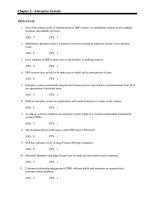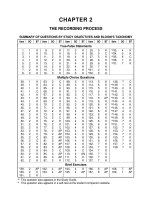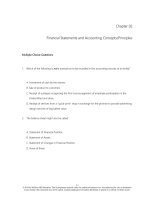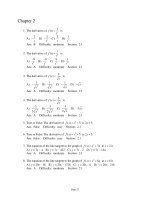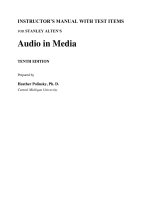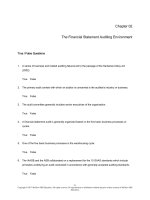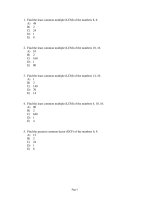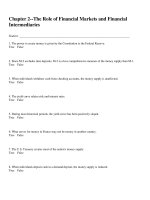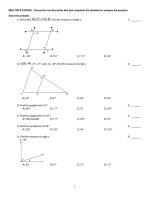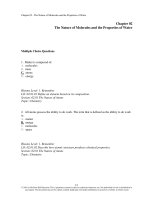Corporate finance 10th edition ross test bank
Bạn đang xem bản rút gọn của tài liệu. Xem và tải ngay bản đầy đủ của tài liệu tại đây (967.41 KB, 92 trang )
Chapter 02
Financial Statements and Cash Flow
Multiple Choice Questions
1.
The financial statement showing a firm's accounting value on a particular date is the:
A. income statement.
B. balance sheet.
C. statement of cash flows.
D. tax reconciliation statement.
E. shareholders' equity sheet.
2.
A current asset is:
A. an item currently owned by the firm.
B. an item that the firm expects to own within the next year.
C. an item currently owned by the firm that will convert to cash within the next 12 months.
D. the amount of cash on hand the firm currently shows on its balance sheet.
E. the market value of all items currently owned by the firm.
3.
The long-term debts of a firm are liabilities:
A. that come due within the next 12 months.
B. that do not come due for at least 12 months.
C. owed to the firm's suppliers.
D. owed to the firm's shareholders.
E. the firm expects to incur within the next 12 months.
2-1
© 2013 by McGraw-Hill Education. This is proprietary material solely for authorized instructor use. Not authorized for sale or distribution in
any manner. This document may not be copied, scanned, duplicated, forwarded, distributed, or posted on a website, in whole or part.
4.
Net working capital is defined as:
A. total liabilities minus shareholders' equity.
B. current liabilities minus shareholders' equity.
C. fixed assets minus long-term liabilities.
D. total assets minus total liabilities.
E. current assets minus current liabilities.
5.
A(n) ____ asset is one which can be quickly converted into cash without significant loss in value.
A. current
B. fixed
C. intangible
D. liquid
E. long-term
6.
The financial statement summarizing a firm's accounting performance over a period of time is the:
A. income statement.
B. balance sheet.
C. statement of cash flows.
D. tax reconciliation statement.
E. shareholders' equity sheet.
7.
Noncash items refer to:
A. the credit sales of a firm.
B. the accounts payable of a firm.
C. the costs incurred for the purchase of intangible fixed assets.
D. expenses charged against revenues that do not directly affect cash flow.
E. all accounts on the balance sheet other than cash on hand.
2-2
© 2013 by McGraw-Hill Education. This is proprietary material solely for authorized instructor use. Not authorized for sale or distribution in
any manner. This document may not be copied, scanned, duplicated, forwarded, distributed, or posted on a website, in whole or part.
8.
Your _____ tax rate is the amount of tax payable on the next taxable dollar you earn.
A. deductible
B. residual
C. total
D. average
E. marginal
9.
Your _____ tax rate is the total taxes you pay divided by your taxable income.
A. deductible
B. residual
C. total
D. average
E. marginal
10. _____ refers to the cash flow that results from the firm's ongoing, normal business activities.
A. Cash flow from operating activities
B. Capital spending
C. Net working capital
D. Cash flow from assets
E. Cash flow to creditors
11. _____ refers to the changes in net capital assets.
A. Operating cash flow
B. Cash flow from investing
C. Net working capital
D. Cash flow from assets
E. Cash flow to creditors
2-3
© 2013 by McGraw-Hill Education. This is proprietary material solely for authorized instructor use. Not authorized for sale or distribution in
any manner. This document may not be copied, scanned, duplicated, forwarded, distributed, or posted on a website, in whole or part.
12. _____ refers to the difference between a firm's current assets and its current liabilities.
A. Operating cash flow
B. Capital spending
C. Net working capital
D. Cash flow from assets
E. Cash flow to creditors
13. _____ is calculated by adding back noncash expenses to net income and adjusting for changes in
current assets and liabilities.
A. Operating cash flow
B. Capital spending
C. Net working capital
D. Cash flow from operations
E. Cash flow to creditors
14. _____ refers to the firm's interest payments less any net new borrowing.
A. Operating cash flow
B. Capital spending
C. Net working capital
D. Cash flow from shareholders
E. Cash flow to creditors
15. _____ refers to the firm's dividend payments less any net new equity raised.
A. Operating cash flow
B. Capital spending
C. Net working capital
D. Cash flow from creditors
E. Cash flow to stockholders
2-4
© 2013 by McGraw-Hill Education. This is proprietary material solely for authorized instructor use. Not authorized for sale or distribution in
any manner. This document may not be copied, scanned, duplicated, forwarded, distributed, or posted on a website, in whole or part.
16. Earnings per share is equal to:
A. net income divided by the total number of shares outstanding.
B. net income divided by the par value of the common stock.
C. gross income multiplied by the par value of the common stock.
D. operating income divided by the par value of the common stock.
E. net income divided by total shareholders' equity.
17. Dividends per share is equal to dividends paid:
A. divided by the par value of common stock.
B. divided by the total number of shares outstanding.
C. divided by total shareholders' equity.
D. multiplied by the par value of the common stock.
E. multiplied by the total number of shares outstanding.
18. Which of the following are included in current assets?
I. equipment
II. Inventory
III. accounts payable
IV. cash
A. II and IV only
B. I and III only
C. I, II, and IV only
D. III and IV only
E. II, III, and IV only
2-5
© 2013 by McGraw-Hill Education. This is proprietary material solely for authorized instructor use. Not authorized for sale or distribution in
any manner. This document may not be copied, scanned, duplicated, forwarded, distributed, or posted on a website, in whole or part.
19. Which of the following are included in current liabilities?
I. Note payable to a supplier in eighteen months
II. Debt payable to a mortgage company in nine months
III. Accounts payable to suppliers
IV. Loan payable to the bank in fourteen months
A. I and III only
B. II and III only
C. III and IV only
D. II, III, and IV only
E. I, II, and III only
20. An increase in total assets:
A. means that net working capital is also increasing.
B. requires an investment in fixed assets.
C. means that shareholders' equity must also increase.
D. must be offset by an equal increase in liabilities and shareholders' equity.
E. can only occur when a firm has positive net income.
21. Which one of the following assets is generally the most liquid?
A. inventory
B. buildings
C. accounts receivable
D. equipment
E. patents
2-6
© 2013 by McGraw-Hill Education. This is proprietary material solely for authorized instructor use. Not authorized for sale or distribution in
any manner. This document may not be copied, scanned, duplicated, forwarded, distributed, or posted on a website, in whole or part.
22. Which one of the following statements concerning liquidity is correct?
A. If you sold an asset today, it was a liquid asset.
B. If you can sell an asset next year at a price equal to its actual value, the asset is highly liquid.
C. Trademarks and patents are highly liquid.
D. The less liquidity a firm has, the lower the probability the firm will encounter financial difficulties.
E. Balance sheet accounts are listed in order of decreasing liquidity.
23. Liquidity is:
A. a measure of the use of debt in a firm's capital structure.
B. equal to current assets minus current liabilities.
C. equal to the market value of a firm's total assets minus its current liabilities.
D. valuable to a firm even though liquid assets tend to be less profitable to own.
E. generally associated with intangible assets.
24. Which of the following accounts are included in shareholders' equity?
I. interest paid
II. retained earnings
III. capital surplus
IV. long-term debt
A. I and II only
B. II and IV only
C. I and IV only
D. II and III only
E. I and III only
2-7
© 2013 by McGraw-Hill Education. This is proprietary material solely for authorized instructor use. Not authorized for sale or distribution in
any manner. This document may not be copied, scanned, duplicated, forwarded, distributed, or posted on a website, in whole or part.
25. Book value:
A. is equivalent to market value for firms with fixed assets.
B. is based on historical cost.
C. generally tends to exceed market value when fixed assets are included.
D. is more of a financial than an accounting valuation.
E. is adjusted to market value whenever the market value exceeds the stated book value.
26. When making financial decisions related to assets, you should:
A. always consider market values.
B. place more emphasis on book values than on market values.
C. rely primarily on the value of assets as shown on the balance sheet.
D. place primary emphasis on historical costs.
E. only consider market values if they are less than book values.
27. As seen on an income statement:
A. interest is deducted from income and increases the total taxes incurred.
B. the tax rate is applied to the earnings before interest and taxes when the firm has both
depreciation and interest expenses.
C. depreciation is shown as an expense but does not affect the taxes payable.
D. depreciation reduces both the pretax income and the net income.
E. interest expense is added to earnings before interest and taxes to get pretax income.
28. The earnings per share will:
A. increase as net income increases.
B. increase as the number of shares outstanding increase.
C. decrease as the total revenue of the firm increases.
D. increase as the tax rate increases.
E. decrease as the costs decrease.
2-8
© 2013 by McGraw-Hill Education. This is proprietary material solely for authorized instructor use. Not authorized for sale or distribution in
any manner. This document may not be copied, scanned, duplicated, forwarded, distributed, or posted on a website, in whole or part.
29. Dividends per share:
A. increase as the net income increases as long as the number of shares outstanding remains
constant.
B. decrease as the number of shares outstanding decrease, all else constant.
C. are inversely related to the earnings per share.
D. are based upon the dividend requirements established by Generally Accepted Accounting
Procedures.
E. are equal to the amount of net income distributed to shareholders divided by the number of
shares outstanding.
30. Earnings per share
A. will increase if net income increases and number of shares remains constant.
B. will increase if net income decreases and number of shares remains constant.
C. is number of shares divided by net income.
D. is the amount of money that goes into retained earnings on a per share basis.
E. None of these.
31. According to Generally Accepted Accounting Principles, costs are:
A. recorded as incurred.
B. recorded when paid.
C. matched with revenues.
D. matched with production levels.
E. expensed as management desires.
2-9
© 2013 by McGraw-Hill Education. This is proprietary material solely for authorized instructor use. Not authorized for sale or distribution in
any manner. This document may not be copied, scanned, duplicated, forwarded, distributed, or posted on a website, in whole or part.
32. Depreciation:
A. is a noncash expense that is recorded on the income statement.
B. increases the net fixed assets as shown on the balance sheet.
C. reduces both the net fixed assets and the costs of a firm.
D. is a non-cash expense which increases the net operating income.
E. decreases net fixed assets, net income, and operating cash flows.
33. When you are making a financial decision, the most relevant tax rate is the __________ rate.
A. average
B. fixed
C. marginal
D. total
E. variable
34. An increase in which one of the following will cause the operating cash flow to increase?
A. depreciation
B. changes in the amount of net fixed capital
C. net working capital
D. taxes
E. costs
35. A firm starts its year with a positive net working capital. During the year, the firm acquires more
short-term debt than it does short-term assets. This means that:
A. the ending net working capital will be negative.
B. both accounts receivable and inventory decreased during the year.
C. the beginning current assets were less than the beginning current liabilities.
D. accounts payable increased and inventory decreased during the year.
E. the ending net working capital can be positive, negative, or equal to zero.
2-10
© 2013 by McGraw-Hill Education. This is proprietary material solely for authorized instructor use. Not authorized for sale or distribution in
any manner. This document may not be copied, scanned, duplicated, forwarded, distributed, or posted on a website, in whole or part.
36. The cash flow to creditors includes the cash:
A. received by the firm when payments are paid to suppliers.
B. outflow of the firm when new debt is acquired.
C. outflow when interest is paid on outstanding debt.
D. inflow when accounts payable decreases.
E. received when long-term debt is paid off.
37. Cash flow to stockholders must be positive when:
A. the dividends paid exceed the net new equity raised.
B. the net sale of common stock exceeds the amount of dividends paid.
C. no income is distributed but new shares of stock are sold.
D. both the cash flow to assets and the cash flow to creditors are negative.
E. both the cash flow to assets and the cash flow to creditors are positive.
38. Which equality is the basis for the balance sheet?
A. Fixed Assets = Stockholder's Equity + Current Assets
B. Assets = Liabilities + Stockholder's Equity
C. Assets = Current Long-Term Debt + Retained Earnings
D. Fixed Assets = Liabilities + Stockholder's Equity
E. None of these
39. Assets are listed on the balance sheet in order of:
A. decreasing liquidity.
B. decreasing size.
C. increasing size.
D. relative life.
E. None of these.
2-11
© 2013 by McGraw-Hill Education. This is proprietary material solely for authorized instructor use. Not authorized for sale or distribution in
any manner. This document may not be copied, scanned, duplicated, forwarded, distributed, or posted on a website, in whole or part.
40. Debt is a contractual obligation that:
A. requires the payout of residual flows to the holders of these instruments.
B. requires a repayment of a stated amount and interest over the period.
C. allows the bondholders to sue the firm if it defaults.
D. Both requires the payout of residual flows to the holders of these instruments; and requires a
repayment of a stated amount and interest over the period.
E. Both requires a repayment of a stated amount and interest over the period; and allows the
bondholders to sue the firm if it defaults.
41. The carrying value or book value of assets:
A. is determined under GAAP and is based on the cost of the asset.
B. represents the true market value according to GAAP.
C. is always the best measure of the company's value to an investor.
D. is always higher than the replacement cost of the assets.
E. None of these.
42. Under GAAP, a firm's assets are reported at:
A. market value.
B. liquidation value.
C. intrinsic value.
D. cost.
E. None of these.
2-12
© 2013 by McGraw-Hill Education. This is proprietary material solely for authorized instructor use. Not authorized for sale or distribution in
any manner. This document may not be copied, scanned, duplicated, forwarded, distributed, or posted on a website, in whole or part.
43. Which of the following statements concerning the income statement is true?
A. It measures performance over a specific period of time.
B. It determines after-tax income of the firm.
C. It includes deferred taxes.
D. It treats interest as an expense.
E. All of these.
44. According to generally accepted accounting principles (GAAP), revenue is recognized as income
when:
A. a contract is signed to perform a service or deliver a good.
B. the transaction is complete and the goods or services are delivered.
C. payment is requested.
D. income taxes are paid.
E. All of these.
45. Which of the following is not included in the computation of operating cash flow?
A. Earnings before interest and taxes
B. Interest paid
C. Depreciation
D. Current taxes
E. All of these are included
46. Net capital spending is equal to:
A. net additions to net working capital.
B. the net change in fixed assets.
C. net income plus depreciation.
D. total cash flow to stockholders less interest and dividends paid.
E. the change in total assets.
2-13
© 2013 by McGraw-Hill Education. This is proprietary material solely for authorized instructor use. Not authorized for sale or distribution in
any manner. This document may not be copied, scanned, duplicated, forwarded, distributed, or posted on a website, in whole or part.
47. Cash flow to stockholders is defined as:
A. interest payments.
B. repurchases of equity less cash dividends paid plus new equity sold.
C. cash flow from financing less cash flow to creditors.
D. cash dividends plus repurchases of equity minus new equity financing.
E. None of these.
48. Free cash flow is:
A. without cost to the firm.
B. net income plus taxes.
C. an increase in net working capital.
D. cash that the firm is free to distribute to creditors and stockholders.
E. None of these.
49. The cash flow of the firm must be equal to:
A. cash flow to stockholders minus cash flow to debtholders.
B. cash flow to debtholders minus cash flow to stockholders.
C. cash flow to governments plus cash flow to stockholders.
D. cash flow to stockholders plus cash flow to debtholders.
E. None of these.
2-14
© 2013 by McGraw-Hill Education. This is proprietary material solely for authorized instructor use. Not authorized for sale or distribution in
any manner. This document may not be copied, scanned, duplicated, forwarded, distributed, or posted on a website, in whole or part.
50. Which of the following are all components of the statement of cash flows?
A. Cash flow from operating activities, cash flow from investing activities, and cash flow from
financing activities
B. Cash flow from operating activities, cash flow from investing activities, and cash flow from
divesting activities
C. Cash flow from internal activities, cash flow from external activities, and cash flow from financing
activities
D. Cash flow from brokering activities, cash flow from profitable activities, and cash flow from nonprofitable activities
E. None of these.
51. One of the reasons why cash flow analysis is popular is because:
A. cash flows are more subjective than net income.
B. cash flows are hard to understand.
C. it is easy to manipulate, or spin the cash flows.
D. it is difficult to manipulate, or spin the cash flows.
E. None of these.
52. A firm has $450 in inventory, $700 in fixed assets, $210 in accounts receivable, $50 in accounts
payable, and $60 in cash. What is the amount of the current assets?
A. $510
B. $560
C. $600
D. $660
E. $720
2-15
© 2013 by McGraw-Hill Education. This is proprietary material solely for authorized instructor use. Not authorized for sale or distribution in
any manner. This document may not be copied, scanned, duplicated, forwarded, distributed, or posted on a website, in whole or part.
53. Total assets are $1000, fixed assets are $700, long-term debt is $250, and short-term debt is $300.
What is the amount of net working capital?
A. $0
B. $50
C. $300
D. $650
E. $700
54. Brad's Company has equipment with a book value of $500 that could be sold today at a 50%
discount. Its inventory is valued at $450 and could be sold to a competitor for that amount. The
firm has $100 in cash and customers owe it $250. What is the accounting value of its liquid assets?
A. $100
B. $550
C. $800
D. $1,050
E. $1,300
55. Martha's Enterprises spent $2,500 to purchase equipment three years ago. This equipment is
currently valued at $2,000 on today's balance sheet but could actually be sold for $2,200. Net
working capital is $300 and long-term debt is $900. Assuming the equipment is the firm's only fixed
asset, what is the book value of shareholders' equity?
A. $1,100
B. $1,400
C. $1,600
D. $1,900
E. The answer cannot be determined from the information provided
2-16
© 2013 by McGraw-Hill Education. This is proprietary material solely for authorized instructor use. Not authorized for sale or distribution in
any manner. This document may not be copied, scanned, duplicated, forwarded, distributed, or posted on a website, in whole or part.
56. Mart's Boutique has sales of $670,000 and costs of $460,000. Interest expense is $50,000 and
depreciation is $55,000. The tax rate is 34%. What is the net income?
A. $35,700
B. $69,300
C. $105,000
D. $138,600
E. $210,000
57. Given the tax rates as shown, what is the average tax rate for a firm with taxable income of
$126,500?
A. 21.38%
B. 23.88%
C. 25.76%
D. 34.64%
E. 39.00%
2-17
© 2013 by McGraw-Hill Education. This is proprietary material solely for authorized instructor use. Not authorized for sale or distribution in
any manner. This document may not be copied, scanned, duplicated, forwarded, distributed, or posted on a website, in whole or part.
58. The tax rates are as shown. Your firm currently has taxable income of $79,400. How much
additional tax will you owe if you increase your taxable income by $21,000?
A. $7,004
B. $7,014
C. $7,140
D. $7,160
E. $7,174
59. Your firm has net income of $198 on total sales of $1,200. Costs are $715 and depreciation is $145.
The tax rate is 34%. The firm does not have interest expenses. What is the operating cash flow?
A. $93
B. $241
C. $340
D. $383
E. $485
60. Awnings Incorporated has beginning net fixed assets of $560 and ending net fixed assets of $720.
Assets valued at $210 were sold during the year. Depreciation was $50. What is the amount of
capital spending?
A. $110
B. $160
C. $210
D. $300
E. $420
2-18
© 2013 by McGraw-Hill Education. This is proprietary material solely for authorized instructor use. Not authorized for sale or distribution in
any manner. This document may not be copied, scanned, duplicated, forwarded, distributed, or posted on a website, in whole or part.
61. At the beginning of the year, a firm has current assets of $420 and current liabilities of $380. At the
end of the year, the current assets are $500 and the current liabilities are $410. What is the change
in net working capital?
A. -$80
B. -$50
C. $0
D. $50
E. $80
62. At the beginning of the year, long-term debt of a firm is $310 and total debt is $350. At the end of
the year, long-term debt is $280 and total debt is $370. The interest paid is $50. What is the
amount of the cash flow to creditors?
A. -$30
B. $0
C. $20
D. $30
E. $80
63. Pete's Boats has beginning long-term debt of $180 and ending long-term debt of $210. The
beginning and ending total debt balances are $340 and $360, respectively. The interest paid is $20.
What is the amount of the cash flow to creditors?
A. -$10
B. $0
C. $10
D. $40
E. $50
2-19
© 2013 by McGraw-Hill Education. This is proprietary material solely for authorized instructor use. Not authorized for sale or distribution in
any manner. This document may not be copied, scanned, duplicated, forwarded, distributed, or posted on a website, in whole or part.
64. Peggy Grey's Cookies has net income of $360. The firm pays out 40% of the net income to its
shareholders as dividends. During the year, the company sold $80 worth of common stock. What is
the cash flow to stockholders?
A. $64
B. $136
C. $144
D. $224
E. $296
65. Thompson's Jet Skis has operating cash flow of $218. Depreciation is $45 and interest paid is $35. A
net total of $69 was paid on long-term debt. The firm spent $180 on fixed assets and increased net
working capital by $38. What is the amount of the cash flow to stockholders?
A. -$104
B. -$28
C. $28
D. $114
E. $142
2-20
© 2013 by McGraw-Hill Education. This is proprietary material solely for authorized instructor use. Not authorized for sale or distribution in
any manner. This document may not be copied, scanned, duplicated, forwarded, distributed, or posted on a website, in whole or part.
66.
What is the change in the net working capital from 2010 to 2011?
A. $1,235
B. $1,035
C. $1,335
D. $3,405
E. $4,740
2-21
© 2013 by McGraw-Hill Education. This is proprietary material solely for authorized instructor use. Not authorized for sale or distribution in
any manner. This document may not be copied, scanned, duplicated, forwarded, distributed, or posted on a website, in whole or part.
67.
What is the amount of the non-cash expenses for 2011?
A. $570
B. $630
C. $845
D. $1,370
E. $2,000
2-22
© 2013 by McGraw-Hill Education. This is proprietary material solely for authorized instructor use. Not authorized for sale or distribution in
any manner. This document may not be copied, scanned, duplicated, forwarded, distributed, or posted on a website, in whole or part.
68.
What is the amount of the net capital spending for 2011?
A. -$290
B. $795
C. $1,080
D. $1,660
E. $2,165
2-23
© 2013 by McGraw-Hill Education. This is proprietary material solely for authorized instructor use. Not authorized for sale or distribution in
any manner. This document may not be copied, scanned, duplicated, forwarded, distributed, or posted on a website, in whole or part.
69.
What is the operating cash flow for 2011?
A. $845
B. $1,930
C. $2,215
D. $2,845
E. $3,060
2-24
© 2013 by McGraw-Hill Education. This is proprietary material solely for authorized instructor use. Not authorized for sale or distribution in
any manner. This document may not be copied, scanned, duplicated, forwarded, distributed, or posted on a website, in whole or part.
70.
What is the cash flow of the firm for 2011?
A. $430
B. $485
C. $1,340
D. $2,590
E. $3,100
2-25
© 2013 by McGraw-Hill Education. This is proprietary material solely for authorized instructor use. Not authorized for sale or distribution in
any manner. This document may not be copied, scanned, duplicated, forwarded, distributed, or posted on a website, in whole or part.
